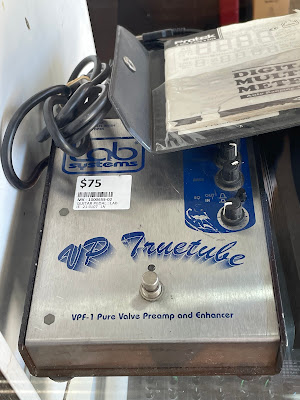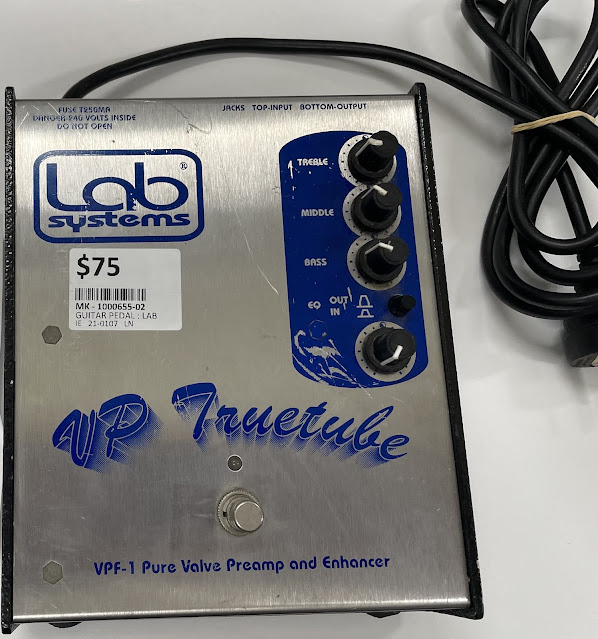Amazing what you can still find in a hock shop in an era when everything (including secondhand gear) has been getting expensive. I went into a local pawn shop to see this peeking through a pile of stuff in the shop window...
I figured given the captive mains lead it actually was based around valve technology, and the cheesy typography on the panel either signified an "AliExpress Special" Chinese product (think early Donner), or an actual boutique manufacturer run by an engineer with questionable graphics design skills. (As an aside, engineers should not be allowed near the Bauhaus font - ever!)
Trying to find a reference to it, there is literally nothing in the current WWW, and Google turned up a complete blank. I could find out that Lab Systems were a well regarded maker of bass amplification in Melbourne the 1980s and 1990s, but ceased trading in the 00s, and while there are some (very folksy) manuals for some of their gear preserved on the web, this wasn't one of them.
Needless to say I was there the next morning, $A75 (about $50 in Freedom Fries currency) in hand-and then the retailer's credit card machine managed to crap the bed and eject its entire roll of thermal paper rather than complete the sale. One instant bank transfer later, however, and this machine was mine!!!!
On plugging it in, the power indicator/footswitch status LED turned on, nothing emitted burning smells, and no circuit breakers tripped, so once I got it home it was time for a look under the hood.
Well, that's definitely a valve poking out from under the circuit board, and some sort of passive EQ circuit on the hot-glued daughter card. The somewhat dodgily screwed-in little transformer has 6.3VAC and 200VAC secondaries, so unlike most modern gear, it seems to run the valve at full rated heater power AND a decent plate voltage. The company that made the transformer is still in business, though unlikely to have any corporate memory of the product. (As an aside, the requirement to get expensive electricity authority approval for every country you sell equipment that runs over 50V inside the case has compromised the design of a lot of valve gear, but electricity authority approval or indeed safety was not on our old mate the engineer's radar, as we shall see later)
Looking more closely at the back of the single-sided main circuit board, nicely retained with shake-proof washers and Loctite retention glue for the screws, we can work out a few things going on even without seeing the other side:

At the bottom, the red 200VAC wires are almost certainly feeding in through resistors to a full-rectifier diode bridge (where the link/bodge wire is), which then goes to a big-ass capacitor to ground (let's call it BAC1), which then feeds via a resistor to BAC2, and then to a couple of plate resistors (the valve evidently contains two independent amplifiers). This configuration was called a Pi filter (because in circuit diagrams it looks like a Pi symbol with two capacitor legs to ground and a resistor or inductor bridging them on top) and is a classic way of filtering mains hum out of the plate voltage for valve supplies. Indeed, after the unit was turned off, BAC1 still had enough charge to arc my screwdriver when I touched it across the contacts. With power on, I measured 279VDC across BAC1, 271V DC across BAC2 (due to the "Pi" resistor dropping voltage) and 190V at the closest valve plate.
Another thing-the "Pure Valve" appellation is truth in advertising-the only silicon in the whole thing is in supply rectifier diodes and the indicator LED. All buffering and amplification in the audio path is done by the valve, and the audio does not pass through any solid-state semiconductors!
At top, the 6.3VAC supply (white wires) is fed directly to the valve heater, and also powers the status LED via a ballast resistor. Whenever the pedal has a "cold start", the LED takes a couple of seconds to reach peak brightness. This would be because the initial inrush current (due to the valve's heater having a low "cold resistance") is causing the dinky transformer to "regulate" and drop its output voltage until the heater warms up - which would have the benefit of soft-starting the valve, thereby prolonging its life.
At bottom left, one of the retention screws connects the circuit ground to the case (which is wired directly to mains earth), but via what appears to be a resistor-or three?
Lastly, it has a mechanical switch bypass which connects the input to the output, but does not bypass the ground-coupling resistor on the output, nor does it disconnect the input from the passive equaliser daughterboard, so not "true bypass". Sorry, cork-sniffers.
So does it work, and does it justify the 75 bucks? Yes and yes.
Plugging my MTD Kingston Heir bass into it, I found it can deliver a nice clean boost (with a small bit of plate noise only noticeable if you're really looking for it, and no discernible hum), plus the EQ is subtle but musically useful.
Part 2 coming soon!!!


















